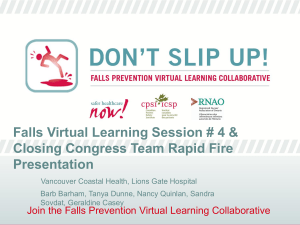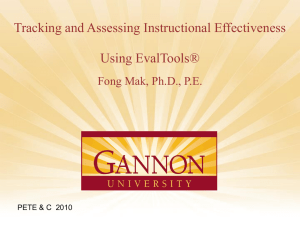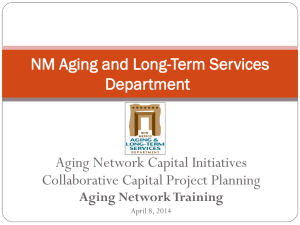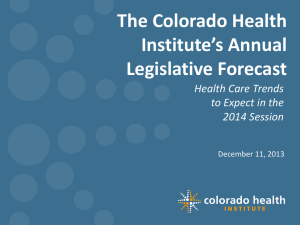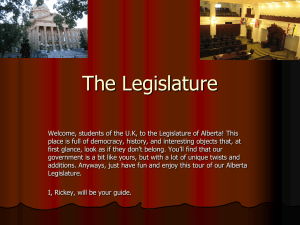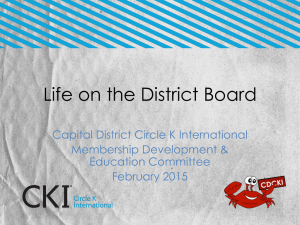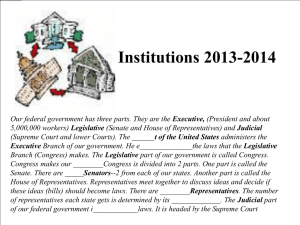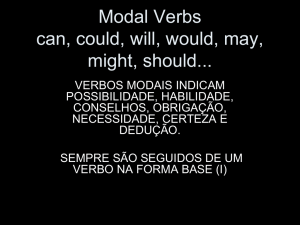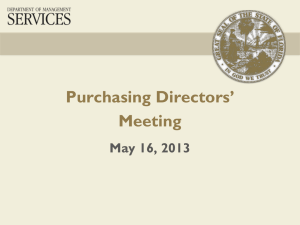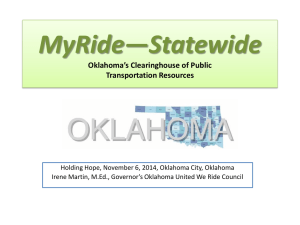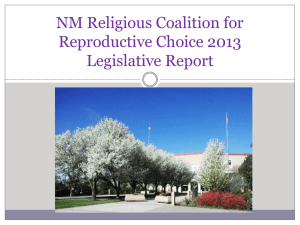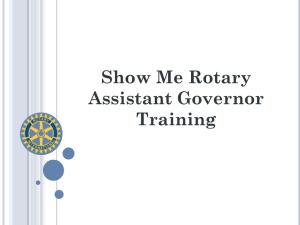Capital Outlay 101 RM - New Mexico State Agency on Aging
advertisement
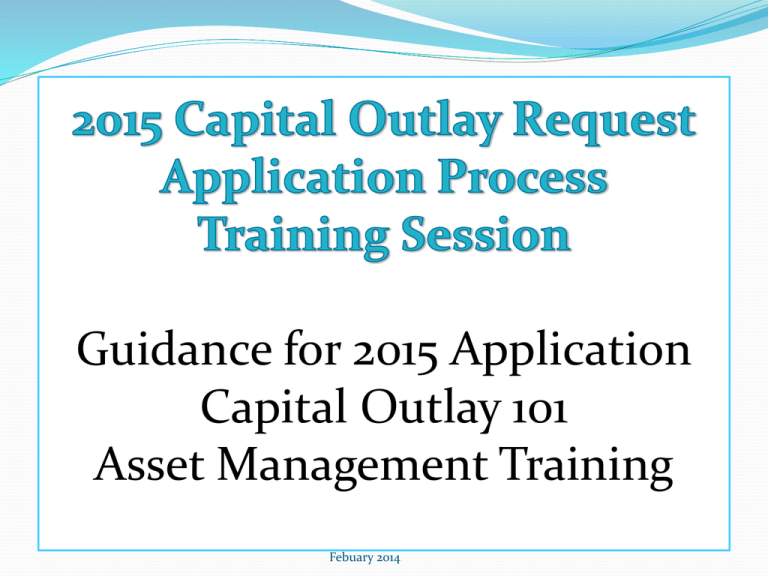
Guidance for 2015 Application Capital Outlay 101 Asset Management Training Febuary 2014 Today’s Agenda 1. Capital Outlay Uses and Guidelines 2. Capital Outlay Request Process Overview 3. Legislative Structure and Process 4. Executive Order 2013-006 – Agency Responsibilities & Grantee Responsibilities 5. Grant Agreement Requirements and Forms 6. 2015 Capital Outlay Request Application 7. Questions & Break Febuary 2014 Today’s Agenda (Continued) Asset Management Introduction – The Big Picture Asset Inventory – Discussion A discussion of the components of asset inventories. Asset Inventory Workshop The group will be given a handout to work through to get some inventory data and to learn what is involved in the process. We will do this in small groups and talk about the results. 5. Level of Service Discussion 6. A discussion of what goes into Level of Service and how it relates to the inventory. 1. 2. 3. 4. Febuary 2014 Capital Outlay 101 Presented by: Rebecca Martinez Capital Projects Bureau Chief Barbara J. Romero Capital Projects Coordinator Febuary 2014 What is Capital Outlay? Capital Outlay is funding intended for the acquisition, improvement, alteration or reconstruction of assets for long term use, including land, buildings, equipment, furnishings, and vehicles. Capital Outlay funds cannot be used for operating expenses, salaries, supplies, events, brochures, retroactive reimbursements of previous payments, loan payments or for a private non governmental entity. The funds are derived from severance tax bonds which are essentially loans the state acquires with various revenues pledged by the state to make the loan payments. Capital Outlay funds do not require a local match, however the legislature will look more favorably on the project if the local government provides fiscal support. Febuary 2014 Capital Outlay (continued) Capital Outlay grants smaller than $5000 are not economically feasible when you consider paperwork, personnel time and loan requirements factored into the cost. Non-construction projects are granted for 2 years and all others are for 4 years with no extension for GOB. It is imperative that the funds be spent within the times set in the grant agreement due to the critical and urgent need for the project. Funds are subject to project warranties and conditions identified in the grant agreement Febuary 2014 N.M. Const., Article IX, Section 14: The Anti-Donation Clause Article 9, Section 14 of the Constitution of New Mexico. The provision that prohibits the state from making direct grants of aid to entities or persons, despite the need or value of the project, unless the strict requirements of the provision are satisfied. (ie. lease agreement, operating agreement, user agreement at fair market value determined by the local government and state agency) The provision provides in pertinent part, "neither the state nor any county, school district or municipality, except as otherwise provided in this constitution, shall directly or indirectly lend or pledge its credit or make any donation to or in aid of any person, association or public or private corporation" The constitution "makes no distinction as between 'donations', whether they be for a good cause or a questionable one. It prohibits them all. Febuary 2014 How do we ask for Capital Outlay funds? The application categories are; construction, code compliance, renovation or other improvements, meals equipment, other equipment and vehicles. The projects within each category are rated and given a score. ALTSD will provide a list of recommended projects for funding All projects for new construction will need to be requested through your local legislator. The projects are compiled on one bill and introduced by one or two sponsors. The bill then goes through the legislative process. Febuary 2014 A brief overview of the Legislature NM Legislature consists of 112 members (70 House of Representatives and 42 Senate) House of Representatives serve 2 year terms and the Senate serve 4 year terms. Capital Outlay Funds are divided in thirds after reserving for Senior Severance Tax Bonds (TIF, WTB, CIF) and rainy day fund (1/3 House of Representatives 1/3 Senate 1/3 Executive) Primary function is to represent the citizens who elect them and to help solve numerous issues throughout the state. The Legislature convenes in regular sessions in Santa Fe at noon on the third Tuesday in January each year. In odd-numbered years the legislature meets for 60 days and in even-numbered years for 30 days. The Governor reserves the right to call a special session concerning matters contained in the proclamation. Febuary 2014 Structure of Government Febuary 2014 Bills and Memorials The main tools used to pass law or actions are bills and memorials. The Legislature considers proposals from simple 1 paragraph bills to over 100-page bills. There are 3 basic types of measures: •Bills: Form used to propose laws. (Requires Governor’s action or signature) •Memorials: Petition or declaration of intent addressed to another governmental body. (Does NOT require Governor’s action to become effective) •Resolutions: Formal declaration on a subject the legislature cannot or doesn’t want to control with legislation. (Does NOT require Governor’s action to become effective) Febuary 2014 Bill passage Bill introduction – bill is assigned a #, read twice, printed, and referred to the proper committee through either the House or Senate (deadline February 5, 2014) Committee review – bill is reviewed by 1 or more committees in the House or Senate. The committee can approve the bill, amend it, forward it to the next committee with no recommendations or kill the bill by tabling it Final vote – If the bill passes it will move to either the House or Senate and repeats the entire process and either singed or vetoed. Enrolling and Engrossing – – bills that pass both House and Senate require the Speaker of the House and President Pro Tempore of the Senate signature then it is sent to the Governor for action. Governors desk - The Governor can sign the bill making it law, veto it, lineitem veto if it contains an appropriation. Bills not signed within 3 days becomes law if the legislature is still in session (Session ends February 20, 2014) . Once the legislature has convened the Governor has 20 days to sign the bill. Unsigned bills are vetoed (March 12, 2014). Signed bills – bills signed by the Governor will become law 90 days after the legislature adjourns (May 21, 2014). The legislature can also indicate an emergency clause which makes the law effective immediately upon signature by the Governor or another specified date. (usually July 1) Febuary 2014 Severance Tax Bond Funds are derived from royalties paid by companies that severe a natural resource from the earth such as oil, gas. timber, mineral products like copper, gypsum, pumice. Use of the funds are subject to the State Board of Finance Bond Project Disbursement Rule NMSA 2.61.6.1 Febuary 2014 General Obligation Bonds 2015 is a General Obligation (GO) bond year. The GO allows the state to borrow money to finance capital improvement projects. Voted on by the electorate. The principal and interest on the bonds are paid out of property tax. This requires a bond issue to be included on the general election ballot. (If passed) Funds will be available after the bonds are sold either in Spring or Winter following the election. Use of the funds are subject to the State Board of Finance Bond Project Disbursement Rule NMSA 2.61.6.1 Febuary 2014 What does Capital Outlay pay for? For new construction of a public facility Improvements to a fixed asset Land acquisition Improvements to roads Information technology Rolling stock (vehicles, fire and emergency, service vehicles and heavy equipment) Code compliance ADA compliance improvements Febuary 2014 How do we get the $$ The Department will issue a grant agreement once it has determined that the fiscal agent is in compliance with the Executive Order 2013-006 The grant agreement will identify the citation of the law, the appropriation amount, legislative intent, expiration date, and the terms and conditions of the use of funds. Fiscal Agent will need to submit a scope of work for each project identifying timeframes and milestones. Capital Outlay funds are on a reimbursement basis. (You must expend the funds first and then submit a request to ALTSD including invoices, cancelled checks and copies of contracts on the approved request form.) Febuary 2014 Executive Order 2013-006 Requirements On May 2, 2013, Governor Susana Martinez signed the EO establishing uniform funding criteria and grant management and oversight requirements for grants of State capital outlay appropriations by State agencies to other entities Ensure that grantee has sound fiscal practices. Ensure grantee submits audits, budgets and financial reports timely - if applicable Agency review of audit to determine deficiencies that would limit the ability to administer the grant Unconstitutional outcomes – Anti donation violation issues Protect public funds Projects are certified as eligible prior to bond sale Uniform grant management practices are met Febuary 2014 Executive Order 2013-006 Agency Responsibilities Complete a funding questionnaire for each grantee Determine if the grantee has the resources to implement the grant agreement if not then a suitable fiscal agent Review audit for deficiencies identified in the opinion letter, financial statements, management discussion and analysis, and supplemental information, internal control, schedule of findings and questioned costs, summary of prior year findings and implement special conditions as part of the grant agreement Monitor grantees compliance with uniform funding criteria and mitigate non-compliance Receive approval of deviations from any of the policies and procedures from DFA Cabinet Secretary prior to implementation Monitor the private use of state capital assets Revise and utilize new grant agreement template Febuary 2014 Executive Order 2013-006 Grantee Responsibilities Provide a comprehensive scope of work, including the timeline and names with contact information for Grantee staff responsible for the project Compliance with the Executive Order 2013-006 Compliance with Infrastructure Capital Improvement Plan (ICIP) Review and compliance with the grant agreement Reporting requirements Expenditure requirements Febuary 2014 Capital Outlay Process (Once Approved by the Legislature and the Executive) The selected projects and funded requests are forwarded to Governor for approval and signature. Upon receipt of the GA, the ALTSD Cabinet Secretary signs off on the contract and forwards a copy of the GA to the local government giving notice to proceed with the project and begin expenditures against the project. ALTSD Capital Outlay Bureau provides project monitoring with periodic site visits to assure progress and compliance with the legislative intent. Notice of funded projects are forwarded to ALTSD (or other designated agency). For projects being funded by the sale of Severance Tax Bonds (STB) or General Obligation Bonds (GOB) project certification for readiness questionnaires are required. NOTE: GO Bonds must be put on the November ballot for the electorate to vote on. GA is then sent back to ALTSD for continued processing. Budgets are established with DFA; creation of purchase documents. Once the Bonds have been sold, ALTSD will “draft” the Grant Agreement which is forwarded to the local or tribal government for review and signature. ALTSD Capital Outlay Bureau provides project monitoring to assure compliance with the legislative intent. Providers/local/tribal governments submit monthly status reports, update the CPMS quarterly as required and submit certified draw requests with source documents to expend funds in a timely manner. Project completion, final inspection, and project close out. Febuary 2014 Grant Agreement Articles Article I - PROJECT DESCRIPTION, AMOUNT OF GRANT AND REVERSION DATE – This article describes the intent of the law, the appropriation amount and the expiration date. Article II –LIMITATION ON DEPARTMENT’S OBLIGATION TO MAKE GRANT DISBURSEMENT TO GRANTEE – This article discusses the ability to make payment and the requirement to submit a Notice of Obligation. Discusses third party obligations Article III - NOTICE PROVISIONS AND GRANTEE AND DEPARTMENT DESIGNATED REPRESENTATIVES – Contact information for grantee and department. Article IV – REVERSION DATE, TERM, EARLY TERMINATION – This article identifies the reversion and the requirement to expend funds on or before that date regardless of a third party contract Article V – EARLY TERMINATION – This article discusses that the department can terminate the agreement once the project is completed, funds were expended in full, violation of terms, mishandling of public funds Article VI – SUSPENSION OF NEW OR FURTHER OBLIGATIONS - This article discusses the departments ability to direct the grantee to cease entering into an obligation. Febuary 2014 Grant Agreement Articles (continued) Article VII – AMENDMENT – both parties must execute any changes to the grant agreement if deemed appropriate by agency. Article VIII – REPORTS – discusses the paper reporting, paperless reporting (CPMS) and the final report and requests for additional information and retention period. Article IX – REQUEST FOR PAYMENT PROCEDURES AND DEADLINES – process for requesting reimbursement, supporting documentation and deadlines. Article X – PROJECT CONDITIONS AND RESTRICTIONS; REPRESENTATIONS AND WARRANTIES – funds must be spent in accordance with state laws, implemented in accordance with NM Public Works Act, must not be in violation of the “Anti-Donation Clause”, project cannot be converted to another use, EEO, Grantee has the ability to receive and expend funds, authorized signatory, agreement does not conflict with grantees obligations, grantee has reviewed and agrees with project description, amount and expiration date and is consistent with the appropriating law, grantee shall abide with all state laws including; conflict of interest, governmental conduct, whistleblower act, language to be included in all contracts and subcontracts regarding lobbying. Article XI - STRICT ACCOUNTABILITY OF RECEIPTS AND DISBURSEMENTS; PROJECT RECORDS – Maintain files for 6 years after the project has been completed Article XII - IMPROPERLY REIMBURSED FUNDS – department has the ability to request funds paid to the grantee under fraud, mismanagement, misrepresentation, misuse, or violation of law. Febuary 2014 Grant Agreement Articles (continued) Article XIII – LIABILITY – NM Tort Claims Act (other party’s acts or omissions) Article XIV – SCOPE OF AGREEMENT – What is written in the agreement shall be what governs the use regardless of any other conversations between grantee and department Article XV – REQUIRED NON-APPROPRIATIONS CLAUSE IN CONTRACTS FUNDED IN WHOLE OR PART BY FUNDS MADE AVAILABLE UNDER THIS AGREEMENT – contingent upon the legislature to authorize and appropriate Article XVI – REQUIRED TERMINATION CLAUSE IN CONTRACTS FUNDED IN WHOLE OR PART BY FUNDS MADE AVAILABLE UNDER THIS AGREEMENT termination clause in all contracts in case department cancels the grant you have the ability to cancel the contract and pay out the liability for goods and or services received to that point. Article XVII – COMPLIANCE WITH UNIFORM FUNDING CRITERIA - EO 2013-006 Article XVIII – SEVERANCE TAX BOND AND GENERAL OBLIGATION BOND PROJECT CLAUSES - subject to the State Board of Finance rules and regulations including the Bond Project Disbursement Rule http://www.nmdfa.state.nm.us/uploads/FileLinks/e9943484096d40d49e26f46f50a9374 8/2_61_6_NEW_disbursement_rule.pdf Febuary 2014 Forms Notice of Obligation – http://www.nmaging.state.nm.us/uploads/FileLinks/24fd7d5d322643389abaf97ee4d330f7/Notice_of_Obligation_Capital_ Grant_Agreement.docx Request for Payment – http://www.nmaging.state.nm.us/uploads/FileLinks/24fd7d5d322643389abaf97ee4d330f7/Exhibit_1_1.pdf Scope of Work http://www.nmaging.state.nm.us/uploads/FileLinks/24fd7d5d322643389abaf97ee4d330f7/Scope_of_Work_template.xlsx CPMS http://nmdfa.state.nm.us/uploads/FileLinks/6583a4770de841daa2d07b9e130326e7/CPMS_Instructions___Local_Entity__ Word__updated_6_7_13.pdf Febuary 2014 2015 Capital Outlay Application Application Guidance CO Forms Febuary 2014 Date Feb. 3 Feb. 5-27 Apr. 11 2015 Timeline 2015 Capital Outlay Application available on-line at http://www.nmaging.state.nm.us/capital-outlay.aspx State-wide Capital Outlay Application Process and Asset Management Planning Deadline to submit 2015 Capital Outlay Application to ALTSD and AAA. May 16 Project Review Teams (AAA’s) conduct initial capital request reviews, rate and rank proposed projects, and submit recommendations to ALTSD for the fundable projects list. June 16 ALTSD finalize recommendations and prepares the request to be submitted to DFA. June 20 ALTSD presents request to the Program Advisory Council. June 30 ALTSD submits final request to DFA for inclusion in State Agency Infrastructure Capital Improvement Plan. Febuary 2014 Questions??? Aging & Long-Term Services Department Capital Projects Bureau P.O. Box 27118 Santa Fe, NM 87502-7118 Rebecca Martinez Barbara Romero Mary Chavez Bureau Chief Coordinator Administrative Assistant 505-476-4768 505-231-2451 cell 505-476-4704 505-476-4879 barbara.romero@state.nm.us maryj.chavez@state.nm.us rebeccas.martinez@state.nm.us Febuary 2014
